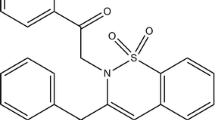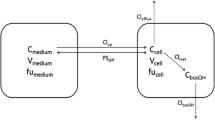Abstract
New approaches in drug development are needed to address the growing epidemic of obesity as the prevalence of obesity increases worldwide. 2,4-Dinitrophenol (DNP) is an oxidative phosphorylation uncoupling agent that was widely used in the early 1930s for weight loss but was quickly banned by the FDA due to the severe toxicities associated with the compound. One of the limitations leading to the demise of DNP as a pharmaceutical was a lack of understanding about the pharmacokinetic–pharmacodynamic relationship. The purpose of this study was to investigate whole body disposition of DNP in order to understand the relationship between the pharmacokinetics, efficacy and toxicity in the C57BL/6J diet induced obese mouse model. Following intravenous administration of 1 mg/kg, and intraperitoneal administration of 5 mg/kg and 15 mg/kg of DNP, we found limited DNP distribution to tissues. Experimentally measured partition coefficients were found to be less than 1 for all analyzed tissues. In addition, DNP exhibits significant nonlinear pharmacokinetics, which we have attributed to nonlinear plasma protein binding and nonlinear partitioning into liver and kidney. By enhancing our understanding of the PK–PD relationship, we can develop new approaches to leverage oxidative phosphorylation uncoupling as a weight loss strategy.





Similar content being viewed by others
Abbreviations
- DNP:
-
2,4-Dinitrophenol
- PK:
-
Pharmacokinetics
- PD:
-
Pharmacodynamics
- PBPK:
-
Physiologically based, pharmacokinetics
- TD:
-
Toxicodynamics
- DIO:
-
Diet induced obese
- IV:
-
Intravenous
- IP:
-
Intraperitoneal
- LC–MS/MS:
-
Liquid chromatography–mass spectrometry
References
Khan SS, Ning H, Wilkins JT, Allen N, Carnethon M, Berry JD, Sweis RN, Lloyd-Jones DM (2018) Association of body mass index with lifetime risk of cardiovascular disease and compression of morbidity. JAMA Cardiol 3(4):280–287. https://doi.org/10.1001/jamacardio.2018.0022
Anderson JW, Konz EC, Frederich RC, Wood CL (2001) Long-term weight-loss maintenance: a meta-analysis of US studies. Am J Clin Nutr 74(5):579–584. https://doi.org/10.1093/ajcn/74.5.579
Araujo JR, Martel F (2012) Sibutramine effects on central mechanisms regulating energy homeostasis. Curr Neuropharmacol 10(1):49–52. https://doi.org/10.2174/157015912799362788
Cutting WC, Mehrtens HG, Tainter ML (1933) Actions and uses of dinitrophenol: promising metabolic applications. J Am Med Assoc 101(3):193–195. https://doi.org/10.1001/jama.1933.02740280013006
Tainter ML (1934) Low oxygen tensions and temperatures on the actions and toxicity of dinitrophenol. J Pharmacol Exp Ther 51(1):45–58
Grundlingh J, Dargan PI, El-Zanfaly M, Wood DM (2011) 2,4-Dinitrophenol (DNP): a weight loss agent with significant acute toxicity and risk of death. J Med Toxicol 7(3):205–212. https://doi.org/10.1007/s13181-011-0162-6
Caldeira da Silva CC, Cerqueira FM, Barbosa LF, Medeiros MH, Kowaltowski AJ (2008) Mild mitochondrial uncoupling in mice affects energy metabolism, redox balance and longevity. Aging Cell 7(4):552–560. https://doi.org/10.1111/j.1474-9726.2008.00407.x
Perry RJ, Kim T, Zhang XM, Lee HY, Pesta D, Popov VB, Zhang D, Rahimi Y, Jurczak MJ, Cline GW, Spiegel DA (2013) Reversal of hypertriglyceridemia, fatty liver disease, and insulin resistance by a liver-targeted mitochondrial uncoupler. Cell Metab 18(5):740–748. https://doi.org/10.1016/j.cmet.2013.10.004
Perry RJ, Zhang D, Zhang XM, Boyer JL, Shulman GI (2015) Controlled-release mitochondrial protonophore reverses diabetes and steatohepatitis in rats. Science 347(6227):1253–1256. https://doi.org/10.1126/science.aaa0672
Goldgof M, Xiao C, Chanturiya T, Jou W, Gavrilova O, Reitman ML (2014) The chemical uncoupler 2,4-Dinitrophenol (DNP) protects against diet-induced obesity and improves energy homeostasis in mice at thermoneutrality. J Biol Chem 289(28):19341–19350. https://doi.org/10.1074/jbc.M114.568204
Holborow A, Purnell RM, Wong JF (2016) Beware the yellow slimming pill: fatal 2,4-dinitrophenol overdose. BMJ Case Rep. https://doi.org/10.1136/bcr-2016-214689
Lawford DJ, King E, Harvey DG (1954) On the metabolism of some aromatic nitro-compounds by different species of animal. II. The elimination of various nitro-compounds from the blood of different species of animal. J Pharm Pharmacol 6(9):619
Sweeney LM, Goodwin MR, Hulgan AD, Gut CP Jr, Bannon DI (2015) Toxicokinetic model development for the insensitive munitions component 2,4-dinitroanisole. Int J Toxicol 34(5):417–432. https://doi.org/10.1177/1091581815594623
Politi L, Vignali C, Polettini A (2007) LC-MS-MS analysis of 2,4-dinitrophenol and its phase I and II metabolites in a case of fatal poisoning. J Anal Toxicol 31(1):55–61
Eiseman JL, Gehring PJ, Gibson JE (1972) The in vitro metabolism of 2,4-dinitrophenol by rat liver homogenates. Toxicol Appl Pharmacol 21(2):275–285
Brown RP, Delp MD, Lindstedt SL, Rhomberg LR, Beliles RP (1997) Physiological parameter values for physiologically based pharmacokinetic models. Toxicol Ind Health 13(4):407–484. https://doi.org/10.1177/074823379701300401
D’Argenio DZ, Wang A (2009) ADAPT 5 User’s guide: pharmacokinetic/pharmacodynamic systems analysis software, biomedical simulations resource, Los Angles
Gabrielsson J, Dolgos H, Gillberg PG, Bredberg U, Benthem B, Duker G (2009) Early integration of pharmacokinetic and dynamic reasoning is essential for optimal development of lead compounds: strategic considerations. Drug Discov Today 14(7–8):358–372. https://doi.org/10.1016/j.drudis.2008.12.011
Wagner J (1971) A new generalized nonlinear pharmacokinetic model and its implications. Biopharm Relevant Pharmacokinet 302–317
Robert TA, Hagardorn AN (1983) Analysis and kinetics of 2,4-dinitrophenol tissues by capillary gas chromatography-mass spectrometry. J Chromatogr B 276:77–84. https://doi.org/10.1016/S0378-4347(00)85067-7
Mager DE, Krzyzanski W (2005) Quasi-equilibrium pharmacokinetic model for drugs exhibiting target-mediated drug disposition. Pharm Res 22(10):1589–1596. https://doi.org/10.1007/s11095-005-6650-0
Administration FaD (2018) FDA guidance: bioanalytical method validation guidance for industry
Peletier LA, Gabrielsson J (2012) Dynamics of target-mediated drug disposition: characteristic profiles and parameter identification. J Pharmacokinet Pharmacodyn 39(5):429–451. https://doi.org/10.1007/s10928-012-9260-6
Gehring PJ, Buerge JF (1969) The distribution of 2,4-dinitrophenol relative to its cataractogenic activity in ducklings and rabbits. Toxicol Appl Pharmacol 15(3):574–592
Zack F, Blaas V, Goos C, Rentsch D, Buttner A (2016) Death within 44 days of 2,4-dinitrophenol intake. Int J Legal Med 130(5):1237–1241. https://doi.org/10.1007/s00414-016-1378-4
Spycher S, Smejtek P, Netzeva TI, Escher BI (2008) Toward a class-independent quantitative structure–activity relationship model for uncouplers of oxidative phosphorylation. Chem Res Toxicol 21(4):911–927. https://doi.org/10.1021/tx700391f
Power A, Pearson N, Pham T, Cheung C, Phillips A, Hickey A (2014) Uncoupling of oxidative phosphorylation and ATP synthase reversal within the hyperthermic heart. Physiol Rep 2(9):e12138. https://doi.org/10.14814/phy2.12138
Berndt WO, Grote D (1968) The accumulation of C14-dinitrophenol by slices of rabbit kidney cortex. J Pharmacol Exp Ther 164(1):223–231
Mudge GH, Taggart JV (1950) Effect of 2,4-dinitrophenol on renal transport mechanisms in the dog. Am J Physiol 161(1):173–180. https://doi.org/10.1152/ajplegacy.1950.161.1.173
Shah DK, Betts AM (2012) Towards a platform PBPK model to characterize the plasma and tissue disposition of monoclonal antibodies in preclinical species and human. J Pharmacokinet Pharmacodyn 39(1):67–86. https://doi.org/10.1007/s10928-011-9232-2
Acknowledgements
This work was supported by NIH Grant GM114179 and AI138195 to D.K.S. and the Centre for Protein Therapeutics at University at Buffalo. L.F.M would like to acknowledge Donald F. and Edna G. Bishop Scholarship Foundation for their continued support.
Author information
Authors and Affiliations
Corresponding author
Additional information
Publisher's Note
Springer Nature remains neutral with regard to jurisdictional claims in published maps and institutional affiliations.
Supplementary Information
Below is the link to the electronic supplementary material.
Rights and permissions
About this article
Cite this article
Meyer, L.F., Rajadhyaksha, P.M. & Shah, D.K. Physiologically-based pharmacokinetic model for 2,4-dinitrophenol. J Pharmacokinet Pharmacodyn 49, 325–336 (2022). https://doi.org/10.1007/s10928-022-09806-y
Received:
Accepted:
Published:
Issue Date:
DOI: https://doi.org/10.1007/s10928-022-09806-y




